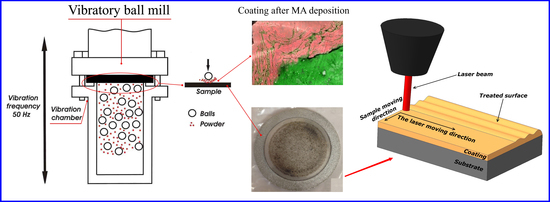Synthesis of Ni-Ti Coatings on Different Metallic Substrates by Mechanical Alloying and Subsequent Laser Treatment
Abstract
:1. Introduction
2. Materials and Methods
3. Results and Discussion
4. Conclusions
Author Contributions
Funding
Conflicts of Interest
References
- Igharo, M.; Wood, J.V. Compaction and Sintering Phenomena in Titanium-Nickel Shape Memory Alloys. Powder Metall. 1985, 28, 131–139. [Google Scholar] [CrossRef]
- Filip, P.; Musialek, J.; Lorethová, H.; Nieslanik, J.; Mazanec, K. TiNi shape memory clamps with optimized structure parameters. J. Mater. Sci. Mater. Med. 1996, 7, 657–663. [Google Scholar] [CrossRef]
- Li, B.Y.; Rong, L.J.; Li, Y.Y.; Gjunter, V.E. Electric resistance phenomena in porous Ni-Ti shape-memory alloys produced by SHS. Scr. Mater. 2001, 44, 823–827. [Google Scholar] [CrossRef]
- Prokofyev, E.; Gunderov, D.; Prokoshkin, S.; Valiev, R. Microstructure, mechanical and functional properties of NiTi alloys processed by ECAP technique. In Proceedings of the ESOMAT 2009 8th European Symposium on Martensitic Transformations, Prague, Czech Republic, 7–11 September 2009; p. 6028. [Google Scholar]
- Kapanen, A.; Ilvesaro, J.; Danilov, A.; Ryhänen, J.; Lehenkari, P.; Tuukkanen, J. Behaviour of Nitinol in osteoblast-like ROS-17 cell cultures. Biomaterials 2002, 23, 645–650. [Google Scholar] [CrossRef]
- Hernández, R.; Polizu, S.; Turenne, S.; Yahia, L. Characteristics of porous nickel-titanium alloys for medical applications. Biomed. Mater. Eng. 2002, 12, 37–45. [Google Scholar] [PubMed]
- Grummon, D.S. Thin-Film Shape-Memory Materials for High-Temperature Applications. JOM 2003, 49, 24–32. [Google Scholar] [CrossRef]
- Jarfors, A.E.W.; Sim, G.C.; San, T.E. Influence of Process Parameters on Reaction Products during Self-Propagating High-Temperature Synthesis of Porous NiTi. Mater. Sci. Forum 2003, 475, 437–438. [Google Scholar] [CrossRef]
- Han, X.; Zou, W.; Wang, R.; Zhang, Z.; Li, T.; Yang, D. Microstructure of TiNi Shape-Memory Alloy Synthesized by Explosive Shock-Wave Compression of Ti-Ni Powder Mixture. J. Mater. Sci. 1997, 32, 4723–4729. [Google Scholar] [CrossRef]
- Takasaki, A. Mechanical Alloying of the Ti-Ni System. Phys. Status Solidi 1998, 169, 183–191. [Google Scholar] [CrossRef]
- Liang, G.X.; Wang, E.D.; Li, Z.M. Effects of ball milling intensity on structural changes in mixed 50Ni-50Ti powders during mechanical alloying process. Mater. Sci. Technol. 1995, 11, 347–350. [Google Scholar] [CrossRef]
- Ye, L.L.; Liu, Z.G.; Raviprasad, K.; Quan, M.X.; Umemoto, M.; Hu, Z.Q. Consolidation of MA amorphous NiTi powders by spark plasma sintering. Mater. Sci. Eng. A 1998, 241, 290–293. [Google Scholar] [CrossRef]
- Gu, Y.W.; Goh, C.W.; Goi, L.S.; Lim, C.S.; Jarfors, A.E.W.; Tay, B.Y.; Yong, M.S. Solid state synthesis of nanocrystalline and/or amorphous 50Ni–50Ti alloy. Mater. Sci. Eng. A 2005, 392, 222–228. [Google Scholar] [CrossRef]
- Mohammadnezhad, M.; Shamanian, M.; Enayati, M.H.; Salehi, M.; Hoseynian, A. Microstructures and properties of NiAl-TiC nanocomposite coatings on carbon steel surfaces produced by mechanical alloying technique. Surf. Coat. Technol. 2014, 238, 180–187. [Google Scholar] [CrossRef]
- Romankov, S.; Kaloshkin, S.D.; Hayasaka, Y.; Sagdoldina, Z.H.; Komarov, S.V.; Hayashi, N.; Kasai, E. Structural evolution of the Ti–Al coatings produced by mechanical alloying technique. J. Alloys Compd. 2009, 483, 386–388. [Google Scholar] [CrossRef]
- Romankov, S.; Kaloshkin, S.D.; Hayasaka, Y.; Hayashi, N.; Kasai, E.; Komarov, S.V. Effect of process parameters on the formation of Ti–Al coatings fabricated by mechanical milling. J. Alloys Compd. 2009, 484, 665–673. [Google Scholar] [CrossRef]
- Yazdani, A.; Zakeri, A. An insight into formation of nanostructured coatings on metallic substrates by planetary ball milling. Powder Technol. 2015, 278, 196–203. [Google Scholar] [CrossRef]
- Varol, T.; Canakci, A. Synthesis and characterization of nanocrystalline Al 2024-B4C composite powders by mechanical alloying. Philos. Mag. Lett. 2013, 93, 339–345. [Google Scholar] [CrossRef]
- Thein, M.A.; Lu, L.; Lai, M.O. Effect of milling and reinforcement on mechanical properties of nanostructured magnesium composite. J. Mater. Process. Technol. 2009, 209, 4439–4443. [Google Scholar] [CrossRef]
- Podrabinnik, P.; Grigoriev, S.; Shishkovsky, I. Laser post annealing of cold-sprayed Al/alumina–Ni composite coatings. Surf. Coat. Technol. 2015, 271, 265–268. [Google Scholar] [CrossRef]
- Shen, L.D.; Huang, Y.H.; Tian, Z.J.; Hua, G.R. Direct Fabrication of Bulk Nanostructured Ceramic from Nano-Al2O3Powders by Selective Laser Sintering. Key Eng. Mater. 2007, 329, 613–618. [Google Scholar] [CrossRef]
- Ajdelsztajn, L.; Jodoin, B.; Schoenung, J.M. Synthesis and mechanical properties of nanocrystalline Ni coatings produced by cold gas dynamic spraying. Surf. Coat. Technol. 2006, 201, 1166–1172. [Google Scholar] [CrossRef]
- Ajdelsztajn, L.; Schoenung, J.M.; Jodoin, B.; Kim, G.E. Cold spray deposition of nanocrystalline aluminum alloys. Metall. Mater. Trans. A 2005, 36, 657–666. [Google Scholar] [CrossRef]
- Bray, M.; Cockburn, A.; O’Neill, W. The Laser-assisted Cold Spray process and deposit characterisation. Surf. Coat. Technol. 2009, 203, 2851–2857. [Google Scholar] [CrossRef]
- Zadorozhnyy, V.Y.; Kaevitser, E.V.; Kopylov, A.N.; Borisova, V.V.; Sudarchikov, R.S.; Khasenov, R.S.; Gorshenko, M.V.; Zadorozhnyy, M.Y.; Kaloshkin, S.D. Synthesis of the hydroxyapatite coatings on the Ti substrates by mechanical alloying. Surf. Coat. Technol. 2015, 281, 157–163. [Google Scholar] [CrossRef]
- Shahzad, A.; Zadorozhnyy, V.Y.; Pavlov, M.D.; Zheleznyi, M.V.; Chirkov, A.M.; Zagrebin, D.S.; Semenov, D.V.; Khasenov, R.S.; Kaloshkin, S.D. Deposition of the Ti-Al coatings on different metallic substrates by mechanical alloying and subsequent laser treatment. J. Alloys Compd. 2018, 731, 1295–1302. [Google Scholar] [CrossRef]
- Zadorozhnyy, V.Y.; Shahzad, A.; Pavlov, M.D.; Kozak, D.S.; Chirkov, A.M.; Zagrebin, D.S.; Khasenov, R.S.; Komarov, S.V.; Kaloshkin, S.D. Synthesis of the Ni-Al coatings on different metallic substrates by mechanical alloying and subsequent laser treatment. J. Alloys Compd. 2017, 707, 351–357. [Google Scholar] [CrossRef]
- Zadorozhnyy, V.; Kaloshkin, S.; Tcherdyntsev, V.; Gorshenkov, M.; Komissarov, A.; Zadorozhnyy, M. Formation of intermetallic Ni-Al coatings by mechanical alloying on the different hardness substrates. J. Alloys Compd. 2014, 586, S373–S376. [Google Scholar] [CrossRef]
- Zadorozhnyy, V.Y.; Kaloshkin, S.D.; Churyukanova, M.N.; Borisova, Y.V. Formation of Intermetallic Ni-Al Coatings by Mechanical Alloying with Different Intensities. Metall. Mater. Trans. A 2013, 44, 1179–1784. [Google Scholar] [CrossRef]
- Zadorozhnyy, V.; Kaloshkin, S.; Kaevitser, E.; Romankov, S. Coating of metals with intermetallics by mechanical alloying. J. Alloys Compd. 2011, 509, S507–S509. [Google Scholar] [CrossRef]
- Khasenova, R.S.; Komarov, S.V.; Zadorozhnyy, V.Y. Mechanical plating of Al/CNT composite coatings on aluminum substrates. J. Alloys Compd. 2017, 707, 238–244. [Google Scholar] [CrossRef]
- Shahzad, A.; Zadorozhnyy, V.Y.; Pavlov, M.D.; Semenov, D.V.; Kaloshkin, S.D. Study and development of NiAl intermetallic coating on hypo-eutectoid steel using highly activated composite granules of the Ni–Al system. Int. J. Mater. Res. 2018, 109, 63–67. [Google Scholar] [CrossRef]
- Panchenko, E.V.; Skakov, Y.A. Laboratoriya Metallografii [Laboratory of the Metallographic]; Metallurgy Publications: Moscow, Russia, 1965; p. 440. (In Russian) [Google Scholar]
- Mandal, T.; Mishra, B.K.; Garg, A.; Chair, D. Optimization of milling parameters for the mechanosynthesis of nanocrystalline hydroxyapatite. Powder Technol. 2014, 253, 650–656. [Google Scholar] [CrossRef]
- Shelekhov, E.V.; Sviridova, T.A. Simulation of Balls Motion and Heating in Planetary-Type Mill. The Effect of Processing Modes onto Mechanical Activa-tion Products of Ni and Nb Powders Mixture. Materialoved 1999, 13–22. [Google Scholar]
- Shelekhov, E.V.; Sviridova, T.A. Programs for X-ray analysis of polycrystals. Met. Sci. Heat Treat. 2000, 42, 309–313. [Google Scholar] [CrossRef]
- Yagodkin, Y.D.; Dobatkin, S.V. Application of electron microscopy and x-ray structural analysis for the determination of sizes of structural elements in nanocrystalline materials (Review). Inorg. Mater. 2008, 44, 1520. [Google Scholar] [CrossRef]
- Mokgalaka, M.N.; Pityana, S.L.; Popoola, P.A.I.; Mathebula, T. NiTi intermetallic surface coatings by laser metal deposition for improving wear properties of Ti-6Al-4V substrates. Adv. Mater. Sci. Eng. 2014. [Google Scholar] [CrossRef]
- Hiraga, H.; Inoue, T.; Kamado, S.; Kojima, Y.; Matsunawa, A.; Shimura, H. Fabrication of NiTi intermetallic compound coating made by laser plasma hybrid spraying of mechanically alloyed powders. Surf. Coat. Technol. 2001, 139, 93–100. [Google Scholar] [CrossRef]
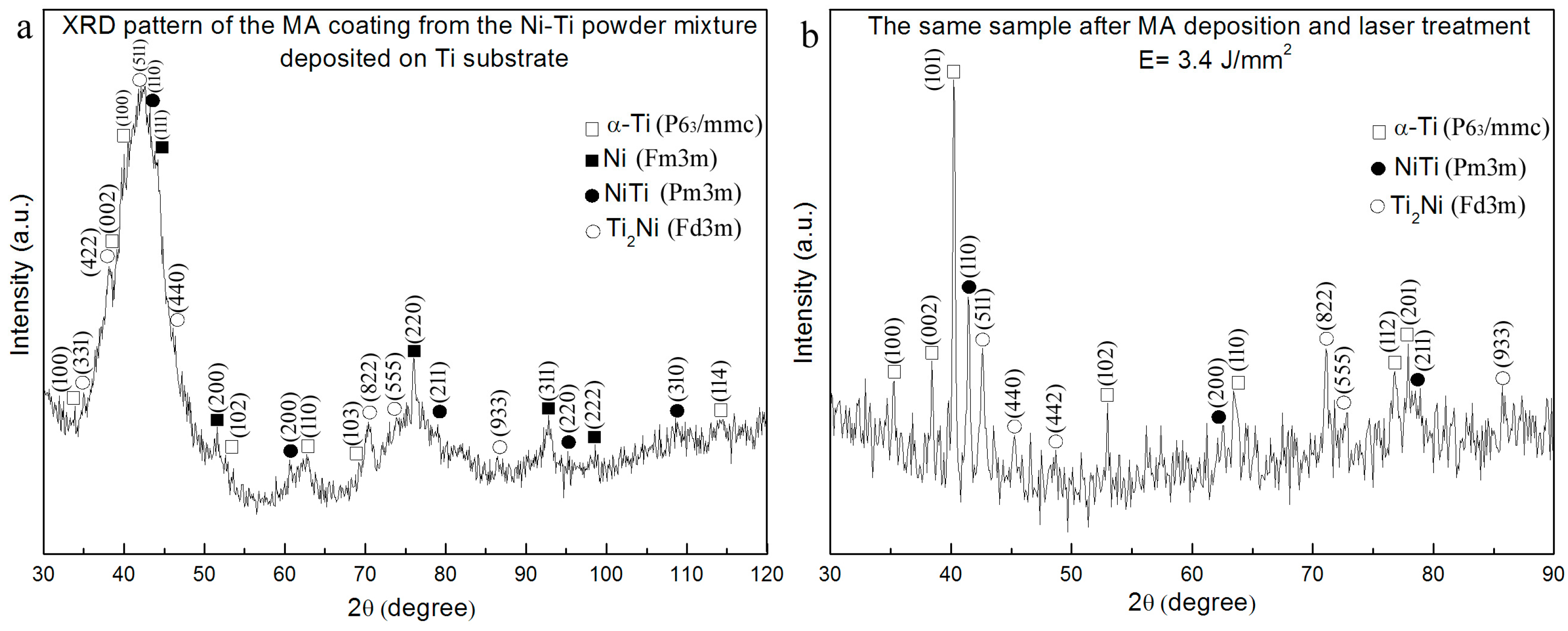
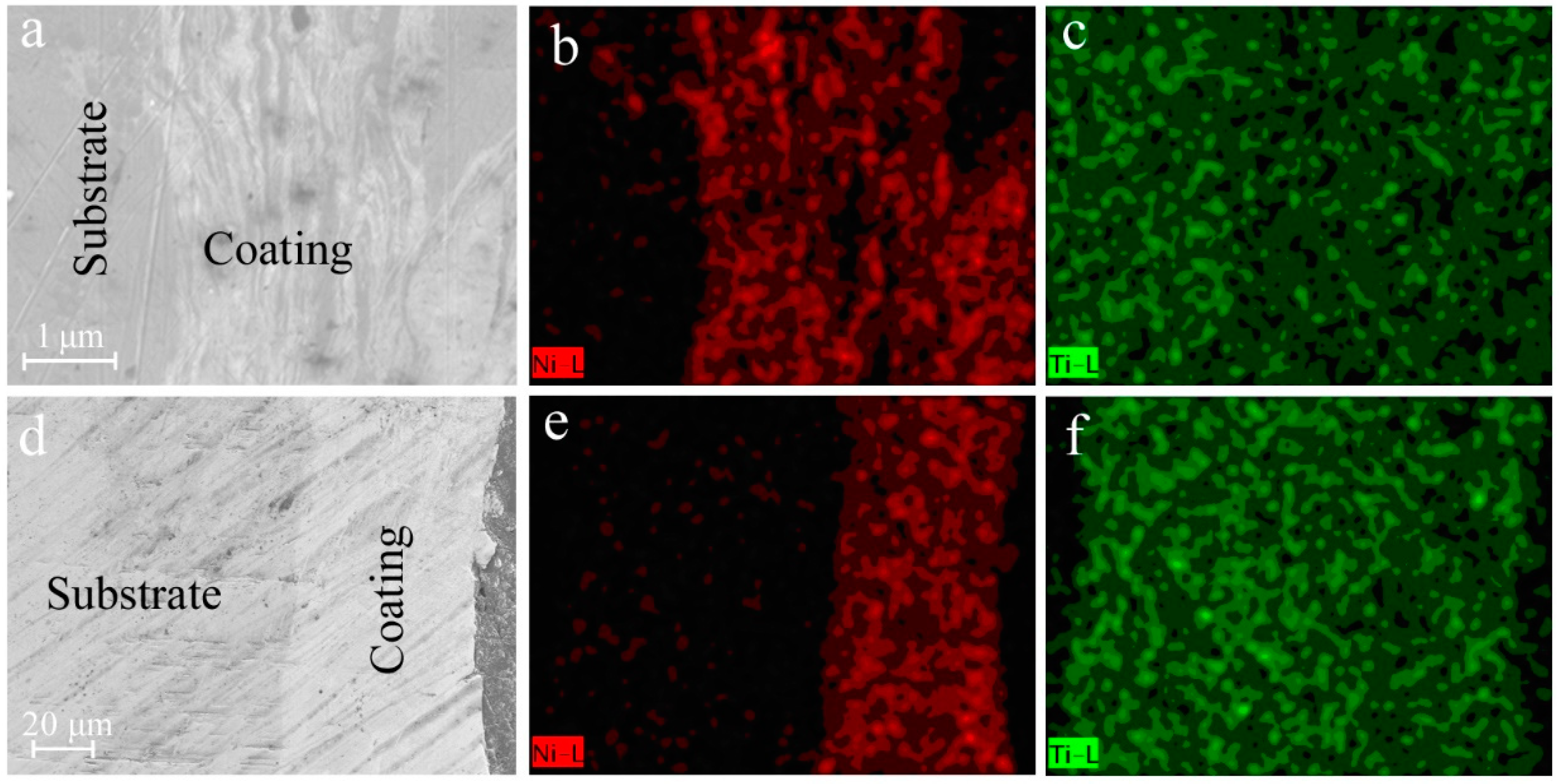
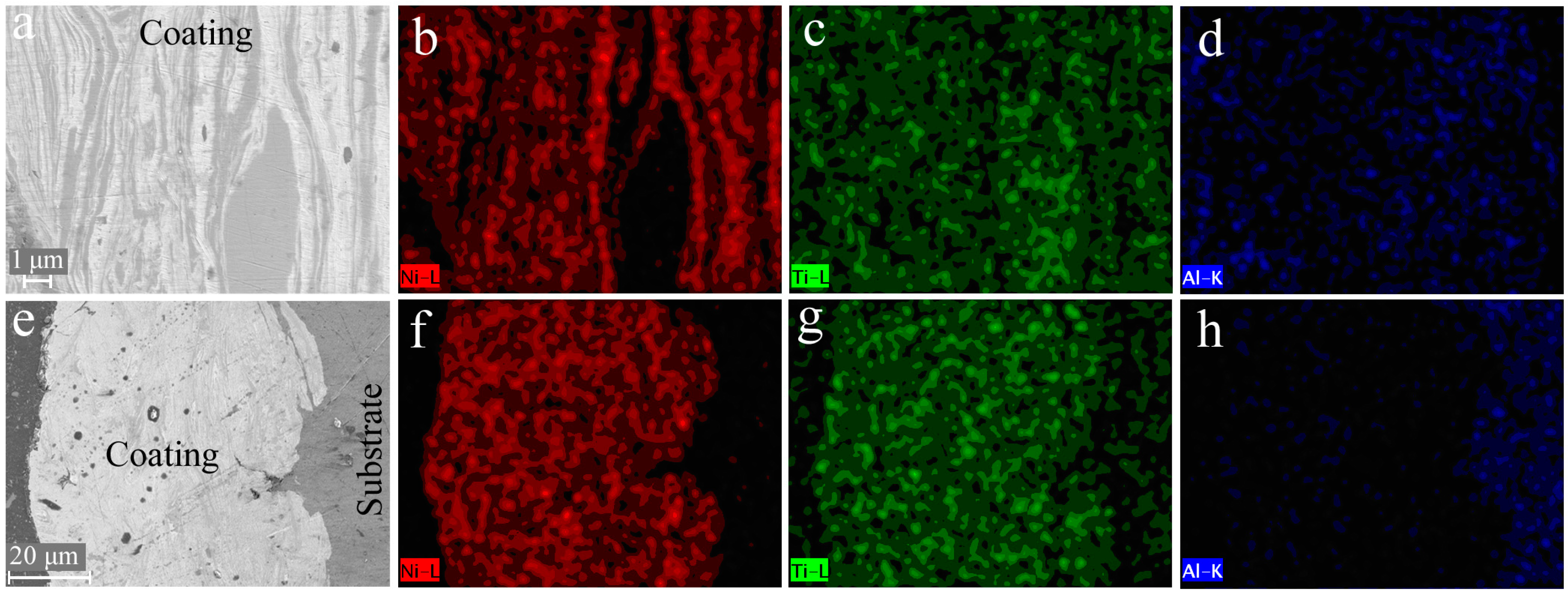
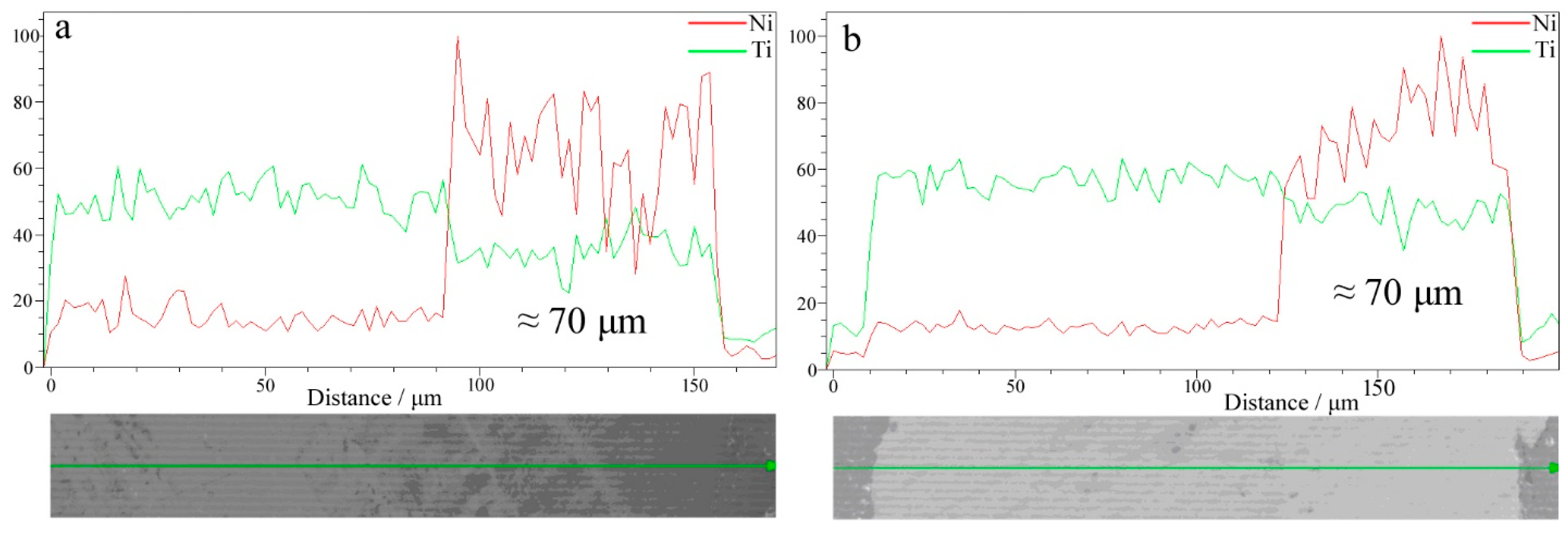
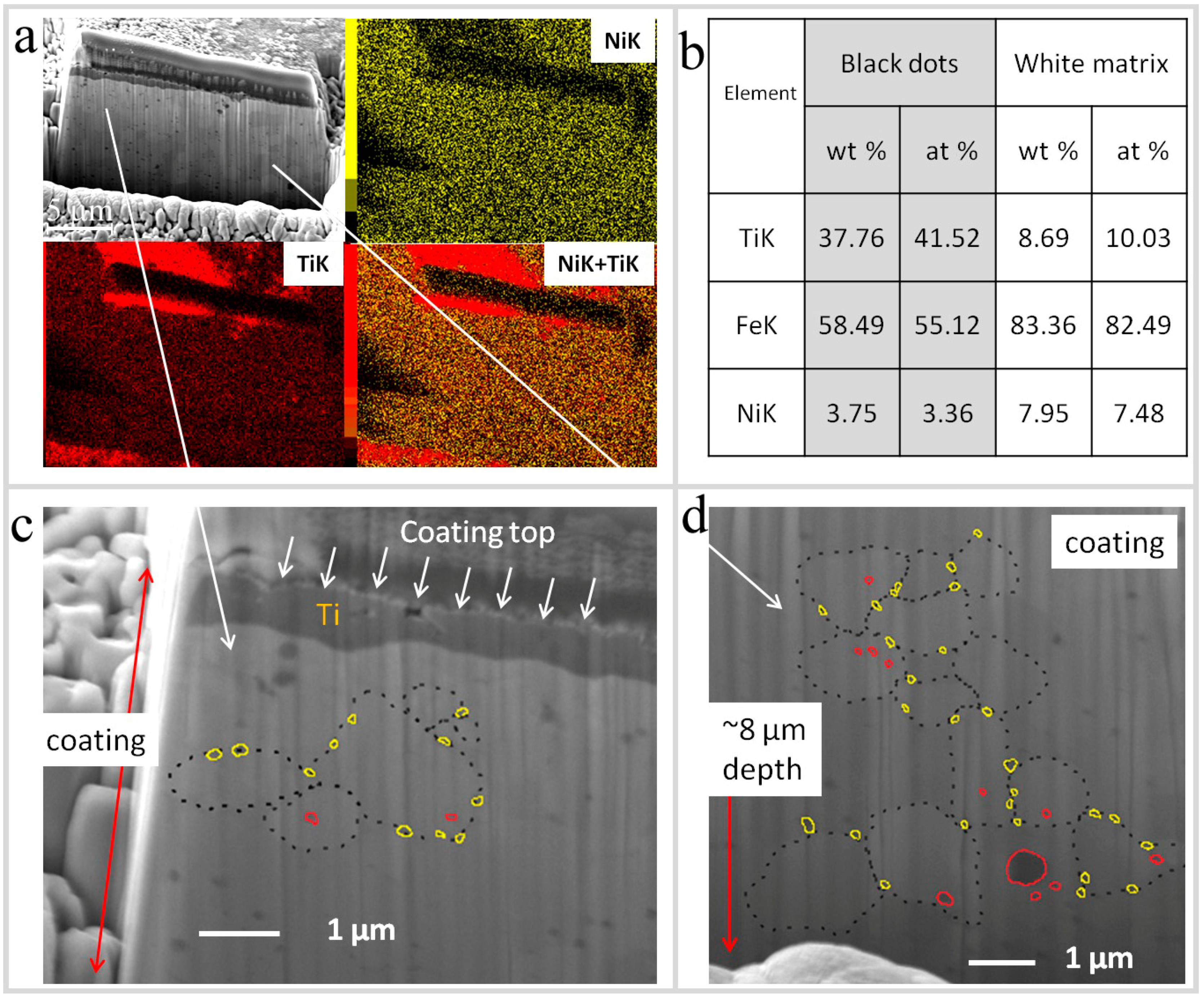
| Phase Composition | Volume Fraction, % | Latticeparameter, nm | Crystallitesize, nm |
|---|---|---|---|
| MA depositionof the NiTipowdermixture on Al-basedalloysubstrate | |||
| Al | 15 | A: 0.4079 | 25 |
| NiTi | 2 | A: 0.2999 | 10 |
| Ti2Ni | 13 | A: 1.0997 | 10 |
| Amorphousphase | 70 | - | - |
| The same sample after MA depositionandlasertreatment E = 8.2 J/mm2 | |||
| Al | 90 | A: 0.4041 | >500 |
| Al2Ti | 10 | A: 0.3976 C: 2.4361 | 30 |
| The same sample after MA depositionandlasertreatment E = 6.8 J/mm2 | |||
| Al | 95 | A: 0.4033 | 100 |
| Ti2Al5 | 5 | A: 0.6188 C: 0.4644 | 10 |
| MA depositionof the NiTipowdermixture on Ti-basedalloysubstrate | |||
| Ti-alpha | 5 | A: 0.2905 C: 0.4650 | 10 |
| Ni | 5 | A: 0.3540 | 10 |
| 5 | |||
| 5 | |||
| NiTi | 5 | A: 0.3008 | 10 |
| 5 | |||
| 5 | |||
| Ti2Ni | 5 | A: 1.1377 | 10 |
| 5 | |||
| 5 | |||
| Amorphousphase | 80 | - | - |
| The same sample after MA depositionandlasertreatment E= 3.4 J/mm2 | |||
| Ti- alpha | 55 | A: 0.2943 C: 0.4682 | >500 |
| NiTi | 25 | A: 0.2994 | >500 |
| NiTi2 | 20 | A: 1.1309 | >500 |
| MA depositionof the NiTipowdermixture on hypoeutectoidsteelsubstrate | |||
| Fe-alpha | 2 | A: 0.2880 | 10 |
| NiTi | 2 | A: 0.3036 | 10 |
| Ti2Ni | 6 | A: 1.1257 | 10 |
| Amorphousphase | 90 | - | - |
| The same sample after MA depositionandlasertreatment E= 13.6 J/mm2 | |||
| Fe-alpha | 80 | A: 0.2904 | >500 |
| Fe2Ti | 15 | A: 0.4838 C: 0.7707 | 50 |
| NiTi | 5 | A: 0.2916 | 50 |
| Microhardness, HV | |||
|---|---|---|---|
| Substrate | Substrate before MA | MA Coating | After Laser Treatment |
| Al-based alloy | 115 | 410 | 450 (E = 8.2 J/mm2) 265 (E = 6.8 J/mm2) |
| Ti-based alloy | 320 | 405 | 680 (E = 3.4 J/mm2) |
| Hypoeutectoid steel | 230 | 1115 | 775 (E = 13.6 J/mm2) |
© 2018 by the authors. Licensee MDPI, Basel, Switzerland. This article is an open access article distributed under the terms and conditions of the Creative Commons Attribution (CC BY) license (http://creativecommons.org/licenses/by/4.0/).
Share and Cite
Zadorozhnyy, V.Y.; Shahzad, A.; Pavlov, M.D.; Chirkov, A.M.; Zagrebin, D.S.; Khasenova, R.S.; Novikov, A.I.; Kaloshkin, S.D. Synthesis of Ni-Ti Coatings on Different Metallic Substrates by Mechanical Alloying and Subsequent Laser Treatment. Metals 2018, 8, 490. https://doi.org/10.3390/met8070490
Zadorozhnyy VY, Shahzad A, Pavlov MD, Chirkov AM, Zagrebin DS, Khasenova RS, Novikov AI, Kaloshkin SD. Synthesis of Ni-Ti Coatings on Different Metallic Substrates by Mechanical Alloying and Subsequent Laser Treatment. Metals. 2018; 8(7):490. https://doi.org/10.3390/met8070490
Chicago/Turabian StyleZadorozhnyy, Vladislav Yu, Aamir Shahzad, Mikhail D. Pavlov, Anatoly M. Chirkov, Dmitry S. Zagrebin, Renata S. Khasenova, Aleksandr I. Novikov, and Sergey D. Kaloshkin. 2018. "Synthesis of Ni-Ti Coatings on Different Metallic Substrates by Mechanical Alloying and Subsequent Laser Treatment" Metals 8, no. 7: 490. https://doi.org/10.3390/met8070490
APA StyleZadorozhnyy, V. Y., Shahzad, A., Pavlov, M. D., Chirkov, A. M., Zagrebin, D. S., Khasenova, R. S., Novikov, A. I., & Kaloshkin, S. D. (2018). Synthesis of Ni-Ti Coatings on Different Metallic Substrates by Mechanical Alloying and Subsequent Laser Treatment. Metals, 8(7), 490. https://doi.org/10.3390/met8070490




